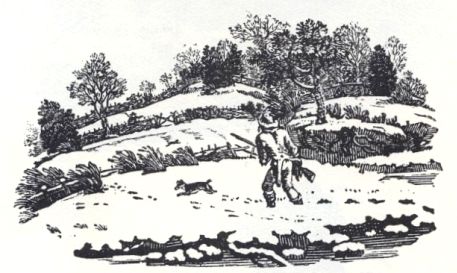December 9
Posted by sydney on Dec 9th, 2008

Snow scene, Thomas Bewick
- 1792: December 9, 1792 – Damage by the wind in some places.
- 1790: December 9, 1790 – Mr Richardson left us. Water-cresses come in.
- 1789: December 9, 1789 – The Emshot hounds kill a leash of hares on the hill.
- 1788: December 9, 1788 – J. Hale clears out the ponds at Little comb.
- 1785: December 9, 1785 – Swans egg pears continue good.
- 1784: December 9, 1784 – Much snow in the night. Vast snow. Snow 16 inches deep on my grass-plot about 12 inches at an average. Farmer Hoar had 41 sheep buried in snow. No such snow since Jan. 1776. In some places much drifted.
- 1782: December 9, 1782 – Rime on the hill.
- 1781: December 9, 1781 – George Tanner’s bullfinch, a cock bird of this year, began from it’s first moulting to look dingy; & is now quite black on the back, rump, & all; & very dusky on the breast. This bird has lived chiefly on hemp-seed. But T. Dewey’s, & __ Horley’s two bull-finches, both of the same age with the former, & also of the same sex, retain their natural colours, which are glossy & vivid, tho’ they both have been supported by hemp-seed. Hence the notion that hemp seed blackens bull-finches does not hold good in all instances; or at least not in the first year.
- 1778: December 9, 1778 – Warm fog, small rain. Vast condensation: the trees on the down, & hanger run in streams down their bodies. Walls sweat. The dew this morning was on the outsides of the windows a token that the air was colder within than without.
- 1777: December 9, 1777 – Grey, sunny, & soft.
- 1774: December 9, 1774 – Almost continual frost from Nov. 20: & some snow frequently falling. Mergus serratus, the Dun-diver, a very rare bird in these parts, was shot in James Knight’s ponds just as it was emerging from the waters with a considerable tench in it’s Mouth. It’s head, & part of the neck, was of a deep rust-colour. On the back part of the head was a considerable crest of the same hue. The sexes in this species, Ray observes, differ so widely, that writers have made two species of them. It appears from Ray’s description that my specimen with the rust-coloured head was a female, called in some parts the sparlin-fowl; & is, he supposes, the female Goosander.
- 1773: December 9, 1773 – Rooks attend their nest-trees in frost only morning & evening.
- 1770: December 9, 1770 – Hail in the night. Frost almost constantly succeeds hail.
- 1768: December 9, 1768 – Wells run over at the bottom of the village.
 Theme Ported to
Theme Ported to